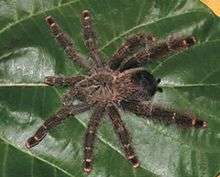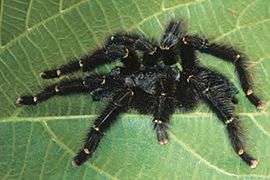Avicularia rufa
Avicularia rufa is a species of spider in the family Theraphosidae.[1] Specimens from the Brazilian states of Mato Grosso and Rondônia have regularly been misidentified as Avicularia juruensis. One difference is the vivid yellow rings on the legs of A. rufa compared to the paler rings of A. juruensis.[2]
| Avicularia rufa | |
|---|---|
 | |
| Female | |
 | |
| Male | |
| Scientific classification | |
| Kingdom: | Animalia |
| Phylum: | Arthropoda |
| Subphylum: | Chelicerata |
| Class: | Arachnida |
| Order: | Araneae |
| Infraorder: | Mygalomorphae |
| Family: | Theraphosidae |
| Genus: | Avicularia |
| Species: | A. rufa |
| Binomial name | |
| Avicularia rufa Schiapelli & Gerschman, 1945[1] | |
Description
Mature individuals have brown carapaces with short golden hairs (setae) with a slight purple sheen. Females have abdomens with long greyish brown hairs on the front of the upper (dorsal) surface and the sides; males have these longer hairs evenly distributed. Both sexes have legs and palps with short brown hairs with a pink sheen and long brown hairs with darker bases and a whitish apex. The femora, tibiae and metatarsi of the legs have vivid yellow rings on the ends furthest from the body.[2]
Taxonomy
Avicularia rufa was first described in 1945 by Schiapelli and Gerschman.[1] Specimens from the Brazilian states of Mato Grosso and Rondônia have been consistently misidentified as Avicularia juruensis. This area is south of the range in which A. jurensis is considered to occur. Apart from differences in the male and female genitalia, A. rufa has bright yellow leg rings, hairs (setae) with a whitish apex on the legs, and leg I shorter than leg IV, whereas A. juruensis has paler yellow leg rings, leg hairs more uniformly coloured, and legs I and IV more-or-less equal in length.[2]
Venom
The neurotoxic venom of Avicularia rufa (misidentified as A. juruensis[2]) has been analysed for potential as an antimicrobial. 11 antimicrobial peptides were found, one of which (named juruin on the assumption that the species was A. juruensis) showed strong activity against fungi. The active components of the venom closely resembled those of other theraphosid spiders, such as Haplopelma schmidti.[3]
References
- "Taxon details Avicularia rufa Schiapelli & Gerschman, 1945", World Spider Catalog, Natural History Museum Bern, retrieved 2017-03-12
- Fukushima, C.S. & Bertani, R. (2017), "Taxonomic revision and cladistic analysis of Avicularia Lamarck, 1818 (Araneae, Theraphosidae, Aviculariinae) with description of three new aviculariine genera", ZooKeys, 659: 1–185, Suppl. 1–5, doi:10.3897/zookeys.659.10717, PMC 5345366, PMID 28331414
- Ayroza, G.; Ferreira, I.L.C.; Sayegh, R.S.R.; Tashima, A.K. & da Silva Junior, P.I. (2012), "Juruin: an antifungal peptide from the venom of the Amazonian Pink Toe spider, Avicularia juruensis, which contains the inhibitory cysteine knot motif", Frontiers in Microbiology, 3 (324): 1–10, doi:10.3389/fmicb.2012.00324, PMC 3437525, PMID 22973266